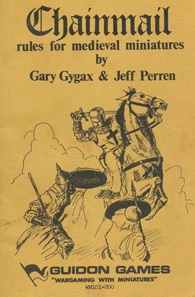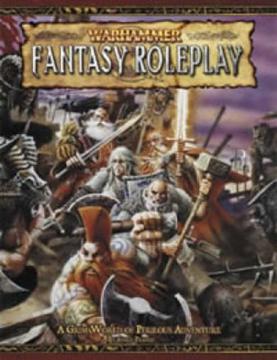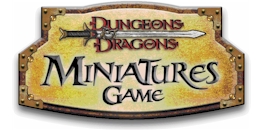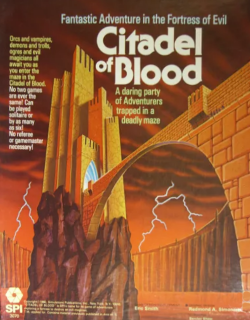
Talisman: The Magical Quest Game is a fantasy-themed adventure board game for two to six players, originally designed and produced by Games Workshop. The game was first released in 1983 and has gone through three revisions. As of 2024, the fifth edition (2024) is the latest version. The board game sold over 800,000 units by 2000.

HeroQuest, is an adventure board game created by Milton Bradley in conjunction with the British company Games Workshop in 1989, and re-released in 2021. The game is loosely based around archetypes of fantasy role-playing games: the game itself was actually a game system, allowing the gamemaster to create dungeons of their own design using the provided game board, tiles, furnishings and figures. The game manual describes Morcar/Zargon as a former apprentice of Mentor, and the parchment text is read aloud from Mentor's perspective. Several expansions have been released, each adding new tiles, traps, artifacts, and monsters to the core system.

Ravenloft is an adventure module for the Dungeons & Dragons (D&D) fantasy role-playing game. The American game publishing company TSR, Inc. released it as a standalone adventure booklet in 1983 for use with the first edition Advanced Dungeons & Dragons game. It was written by Tracy and Laura Hickman, and includes art by Clyde Caldwell with maps by David Sutherland III. The plot of Ravenloft focuses on the villain Strahd von Zarovich, a vampire who pines for his lost love. Various story elements, including Strahd's motivation and the locations of magical weapons, are randomly determined by drawing cards. The player characters attempt to defeat Strahd and, if successful, the adventure ends.

Warhammer is a tabletop miniature wargame with a medieval fantasy theme. The game was created by Bryan Ansell, Richard Halliwell, and Rick Priestley, and first published by the Games Workshop company in 1983.

Warhammer Quest is a fantasy dungeon, role-playing adventure board game released by Games Workshop in 1995 as the successor to HeroQuest and Advanced HeroQuest, set in its fictional Warhammer Fantasy world. The game focuses upon a group of warriors who join to earn their fame and fortune in the darkest depths of the Old World.

Chainmail is a medieval miniature wargame created by Gary Gygax and Jeff Perren. Gygax developed the core medieval system of the game by expanding on rules authored by his fellow Lake Geneva Tactical Studies Association (LGTSA) member Jeff Perren, a hobby-shop owner with whom he had become friendly. Guidon Games released the first edition of Chainmail in 1971.
The Enemy Within campaign is a series of adventures for Warhammer Fantasy Roleplay where hidden powers of Chaos plot the destruction of the Empire. It was originally published by Games Workshop in the late 1980s. Praised as a detailed campaign that actually told a story, it was voted the best RPG campaign of all time by Casus Belli magazine.

Ken Rolston is an American computer game and role-playing game designer best known for his work with West End Games and on the computer game series The Elder Scrolls. In February 2007, he elected to join the staff of computer games company Big Huge Games to create a new role-playing game.

The Veiled Society is an adventure module for the Basic Rules of the Dungeons & Dragons fantasy role-playing game published in 1984. The adventure's product designation is TSR 9086.

Warhammer Fantasy Roleplay or Warhammer Fantasy Role-Play is a role-playing game set in the Warhammer Fantasy setting, published by Games Workshop or its licensees.
Mighty Warriors is an adventure board game created by Games Workshop in 1991 and set in the Warhammer Fantasy fictional universe. The core rules allowed players to explore dungeons, which were randomly generated, and fight monsters, also randomly generated. This was a simplified version of Advanced Heroquest.

The Dungeons & Dragons Computer Labyrinth Game is an electronic board game released by Mattel in 1980.

The Dungeons & Dragons Miniatures Game is a collectible miniatures game played with pre-painted, plastic miniature figures based on characters and monsters from the Dungeons & Dragons game. The figures are 30mm in scale. Produced by Wizards of the Coast, the Dungeons & Dragons Miniatures line is composed of 20 loosely themed sets that were released roughly every four months since the line was launched in 2003 until its cancellation in 2011.

Rage of the Rakasta is an adventure for the Rules Cyclopedia edition of the Dungeons & Dragons fantasy role-playing game, published in 1993.

Dungeon Floor Plans is a supplement for fantasy role-playing games published by Games Workshop in 1978.

Citadel of Blood, subtitled "Fantastic Adventure in the Fortress of Evil". is a dungeon-crawl board game published by Simulations Publications, Inc. (SPI) in 1980.
Dan Glimne, whose full name is Dan Ejde Gustaf Glimne, is a Swedish games expert, game designer and "famous poker player" who is "very interested in traditional games".

Labyrinthine is a fantasy board game published by Wee Warriors in 1977. Based on themes taken from the then-newly published Dungeons & Dragons, Labyrinthine was the first "dungeon crawler" board game to use a totally modular board that was reconfigured for each game.

Heroes for Dungeonquest is a supplement published by Games Workshop (GW) in 1987 for the fantasy board game Dungeonquest.
Kellar's Keep is an anthology of sequentially linked scenarios jointly published by Milton Bradley and Games Workshop in 1991 for the fantasy adventure board game HeroQuest .
















